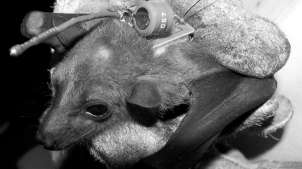Bats' echolocation recorded for human exploit

Bats' remarkable ability to 'see' in the dark uses the echoes from their own calls to decipher the shape of their dark surroundings. This process, known as echolocation, allows bats to perceive their surroundings in great detail, detecting insect prey or identifying threatening predators, and is a skill that engineers are hoping to replicate.
A team of British researchers has worked with six adult Egyptian fruit bats from Tropical World in Leeds to record and recreate their calls. These calls are pairs of 'clicks' from the bats' tongues that they use to fill their surroundings with acoustic energy; the echoes that return allow the bats to form an image of their environment.
New research published today, Tuesday 11 May, in IOP Publishing's Bioinspiration & Biomimetics, describes how engineers and biologists from the Universities of Strathclyde and Leeds worked with the bats to record their double-click echolocation call, and its returning echoes, using a miniature wireless microphone sensor mounted on the bat whilst in flight.
During echolocation, some bats are known to use a natural acoustic gain control. This allows them to emit high-intensity calls without deafening themselves, and then to hear the weak echoes returning from surrounding objects. The researchers replicated this system in electronics to allow the sensor to record both the emitted and reflected echolocation signals, providing an insight into the full echolocation process.
The six bats performed up to sixteen flights each along a flight corridor. Each flight was short - lasting only about three seconds - but, with the bats' clicks only lasting a quarter of a millisecond, a large number of calls were recorded for the scientists to analyse.
Once back into the laboratory, the researchers were able to accurately recreate the echolocation calls using a custom-built ultrasonic loudspeaker. This technique will allow the signals and processes bats use to be applied to human engineering systems such as sonar. Specifically, the researchers are looking to apply these techniques in the positioning of robotic vehicles, used in structural testing applications.
Lead author Simon Whiteley from the Centre for Ultrasonic Engineering at the University of Strathclyde, said, "We aim to understand the echolocation process that bats have evolved over millennia, and employ similar signals and techniques in engineering systems. We are currently looking to apply these methods to positioning of robotic vehicles, which are used for structural testing. This will provide enhanced information on the robots' locations, and hence the location of any structural flaws they may detect."
More information: The article is available at iopscience.iop.org/1748-3190/5/2/026001
Provided by Institute of Physics

















